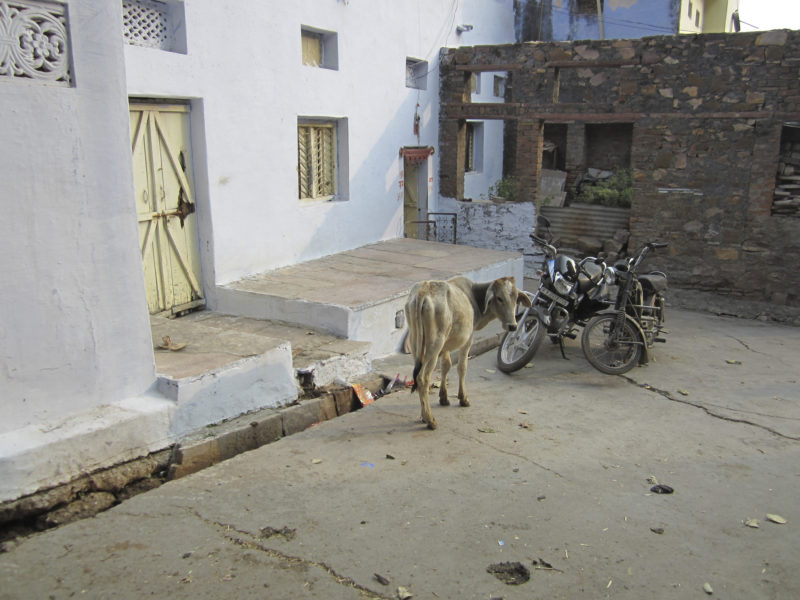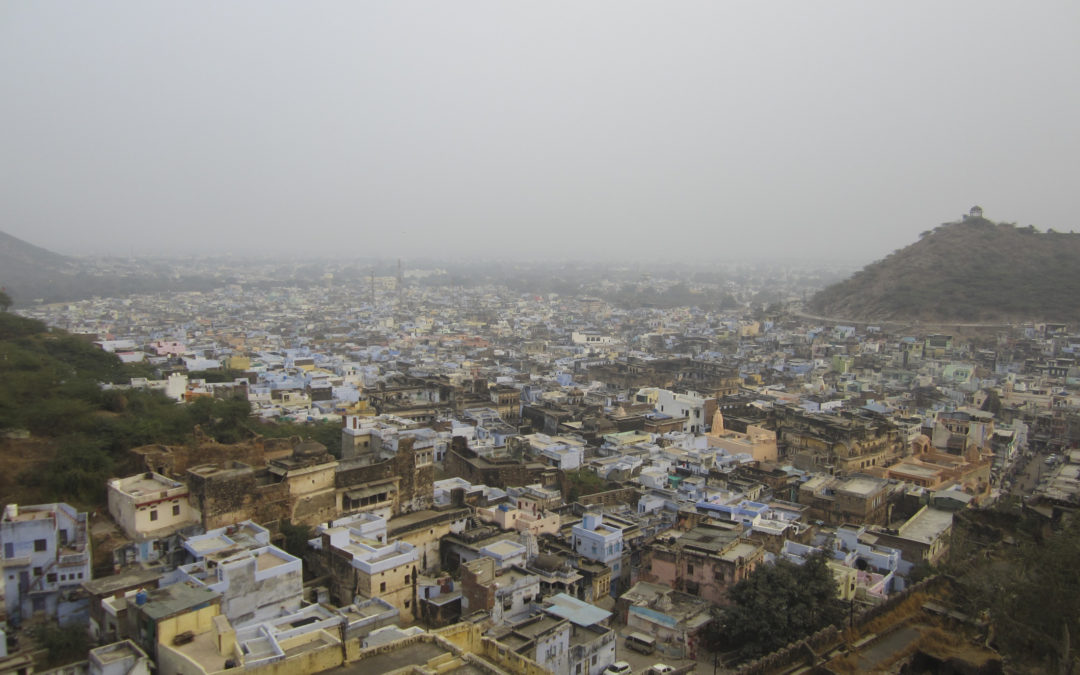Next stop was Ranthambore National Park which is the best place for spotting Bengal tigers. It was once the private hunting ground for the kings of Jaipur but since 1957 has been a safe place for them to thrive.

Banyon (?) tree in the park
We stayed in a very cool fort hotel with paintings and photos of the royal family, complete with beautiful courtyards and little nooks for reading or Facebooking. It made me feel like I was in the true Rajasthan. In the evening we sat around an open fire and had gin and tonics. The one thing that bothered me that there was a tiger skin and taxidermied growling tiger heads on the walls of the restaurant.

Raj Palace Resort
I was glad to hear that hunting has been banned in India since 1972 when they realized that no, tigers are not in infinite supply. There are currently about 2,500 tigers in India today thanks to a conservation effort called Project Tiger. Did you know their numbers are actually increasing? Some good news for once.
Jes and I dressed the part for our safari with earthy toned clothes and aviator sunglesses. We looked very cool. Mariel the American I think wore camouflage pants, or at least was threatening to wear her camo pants. We were picked up by a huge open jeep type vehicle. Our tour guide had bad red teeth due to chewing betel nut, a stimulant that is similar in effect to coffee. It’s hard not to stare at those stained red teeth sometimes. When we were driving to the park, we passed a pimped out tractor blasting music and driving really fast. Everyone was startled by this, but the tour guide just laughed and flicked his hand in the air and yelled “I love my India!”
When we arrived at the park, we were told there are 9 baby tigers this year. The deer are very well fed there and there quite a lot of them. The tigers in turn must be also very well fed because I can’t quite imagine those deer running very quickly. Because this park used to be a royal hunting ground, there are many stone structures that were used for “blinds” to hunt the tigers or shacks to hang out in? Not sure what they were for, but now they are abandoned and during the hot summers, the tigers hang out it in them keep cool. Which makes for very cool photos.

Tiger in a stone temple. Not my photo!
We were hopeful we’d see some tigers, but of course it’s not a zoo, and we went in the afternoon… meaning we saw crocs, deer and monkeys but no tigers. Some one had heard a roar earlier but unfortunately got skunked on the tiger sighting. I was very disappointed. But also had to pee really bad and didn’t want to go in the bushes in case I in fact did see a tiger face to face.
At the end of the day, the only tigers we saw were the skins on the walls and framed photos.

The only tigers we saw were on the wall
The next day we took some jeeps to Bundi, a relatively unknown small backpacker town. We were taken to a run down fort with some incredible murals. It was so great not to be fighting for space with other westerners… we were the only whiteys there. The murals were just so fantastic I could have spent two hours there. They depicted some Hindu mythology, some royal family stories, including elephant fighting which was a ridiculous tradition. Elephants by nature are not very fightey, so the royal family would starve the males and not let them drink for a couple days then only feed them alcohol and hash so they went crazy enough to fight with each other.

Elephant fighting mural
On the way out of the fort, I saw a large animal which looked like an otter running along a weedy ledge. I stopped in my tracks and kept watching… then asked the guide what the animal was and he told me a mongoose! It reminded me of how much I loved Rudyard Kipling’s short story Riki Tiki Tavi and made me realize in a strange way that holy shit I’m in INDIA!

Run down amazing fort
We visited a really cool large structure called a “step well” which was in the past used for drinking, bathing and washing. Each well has a unique purpose. They have not been used for a few decades now but they are an ingenious design. During the monsoon season (July & August), the structure pretty well fills up to the top. Then as the seasons go by with no rain, the water is used up and evaporates, exposing a series of steps which people can walk down and collect water / bathe / wash.

Step well
Bundi is very ruin-porny … reminded me of Havana a little. It’s very photogenic … every time I turned around I felt like taking more photos. We visited the “World’s best masala chai” which was quite peppery. Who knew there was pepper in masala chai? I sure didn’t! Oh, and I also learned that when we say “chai tea” we’re actually saying “tea tea”. “Masala” means “spice” … and “chai” means “tea”. The tea guy had this amazing sign which you can see in the photo. We weren’t too sure if it was tongue in cheek or or not. We figured later, maybe it’s not a joke which makes it all the more delightful. India!

World’s best masala chai and mostly all over foreign countries

Bundi
On a walk we fed a nice cow an orange, and our fellow tour member Sarah from England decided to scratch the cow’s head or something but the cow decide she did NOT like that, and attacked Sarah and head butted her a little. After that I decided that the holy cows were best avoided and gave them a wide berth. They have attitude.

Cow just before the charge
All in all, Bundi is full of personality and made me think this is what all of India was like a few decades ago before having the sewage systems a little more modernized and actually have paved streets etc.

Monkeys in Bundi

